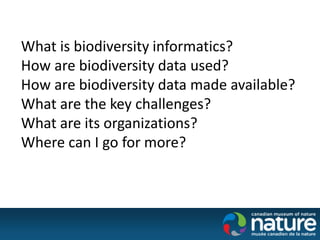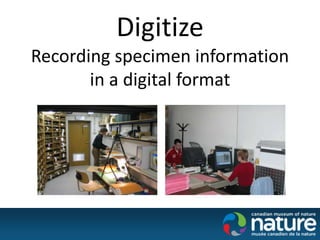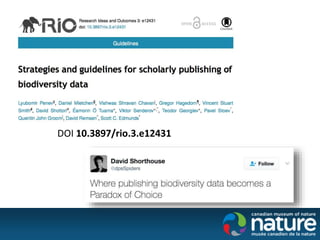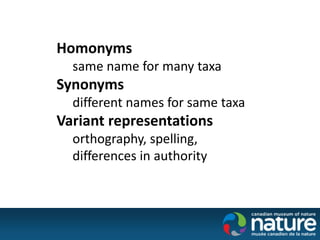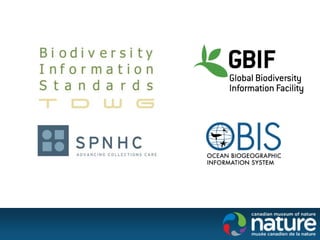2018 04-03-shorthouse
- 1. Biodiversity Informatics David P. Shorthouse Assistant Collections Information Manager Canadian Museum of Nature @dpsSpiders dshorthouse@nature.ca
- 2. © Mr.checker (CC-SA 3.0 Unported)
- 4. What is biodiversity informatics? How are biodiversity data used? How are biodiversity data made available? What are the key challenges? What are its organizations? Where can I go for more?
- 5. Bioinformatics focused on the *omics
- 6. Biodiversity Informatics interoperability of scientific names, classifications
- 7. Biodiversity Informatics Biodiversity informatics describes a new, synthetic discipline that integrates biological research, computational science, and software engineering to deal with biotic data—their storage, integration, retrieval, and use in analysis, prediction, and decision-making
- 8. History of “Biodiversity Informatics” John S. Whiting Canadian Biodiversity Informatics Consortium (1993)
- 9. Johnson Norm F. 2007. Biodiversity informatics. Annu Rev Entomol. 52:421-38. DOI 10.1146/annurev.ento.52.110405.091259
- 12. How are biodiversity data used?
- 13. Chapman, A. D. 2005. Uses of Primary Species-Occurrence Data, version 1.0. Report for the Global Biodiversity Information Facility, Copenhagen. http://www.gbif.org/resources/80545
- 14. 1 Taxonomy: research, indices, floras/faunas, field guides, phylogenies 2 Biogeography: distributional atlases, species distribution modeling, species decline 3 Life Histories and Phenologies 4 Endangered, Migratory, and Invasive Species 5 Impact of Climate Change 6 Ecology, Evolution and Genetics: habitat loss, ecosystem function 7 Environmental Planning: impact assessments Uses of Primary Occurrence Data
- 15. Uses of Primary Occurrence Data 8 Conservation Planning: rapid biodiversity assessments, identifying priority areas, reserve selection, sustainable use 9 Health and Public Safety: disease and disease vectors, bioterrorism, biosafety, parasitology 10 Bioprospecting 11 Border Control and Wildlife Trade 12 Education and Public Outreach 13 Ecotourism 14 Society and Politics: data repatriation 15 Recreational activities
- 18. How are biodiversity data made available?
- 20. Collect
- 21. Prepare Creating a long-term voucher for scientific research
- 23. Specimen label Primary biodiversity data What, when, where & who
- 24. Digitize Recording specimen information in a digital format
- 25. Standardize Different database systems Different formats Different languages
- 26. Darwin Core A common biodiversity information language bit.ly/DarwinCore
- 27. 185 terms
- 28. Darwin Core Archive A common biodiversity information format
- 30. Publish Make available online GBIF Integrated Publishing Toolkit (IPT)
- 32. 5M records published by Canada 33M records published on Canada
- 33. Data license Allow data to be used bit.ly/cc0-for-data
- 35. What are the key challenges?
- 36. Global List of All Species
- 38. Homonyms same name for many taxa Synonyms different names for same taxa Variant representations orthography, spelling, differences in authority
- 42. 1.Standards and protocols 2.Training & education 3.Data storage & exchange 4.Data types 5.Data quality & fitness for use
- 43. DOI 10.1016/j.ecoinf.2013.11.002 © Biopix (CC-BY-NC) Aglais urticae Linnaeus 1758 Small Tortoiseshell
- 46. Connecting What We Have
- 51. What are (a few of) the Biodiversity Informatics organizations?
- 55. What about Canadian Organizations? Canadian Biodiversity Information Facility OBIS Canada Canadensys Alliance of Natural History Museums of Canada Canadian Centre for DNA Barcoding
- 56. Where can I go for more?
- 58. What Skills/Technologies Might I Need? Web programming: HTML5, css Relational databases: PostgreSQL/PostGIS, MySQL NoSQL data stores: Neo4j, CouchDB Programming languages: R, Python, ruby, Java, JavaScript Creativity with data: dynamic visualizations
- 59. Total prize monies: €34,000 Deadline: Wednesday, 5 September 2018, at 1600 GMT
- 61. What is biodiversity informatics? How are biodiversity data used? How are biodiversity data made available? What are the key challenges? What are its organizations? Where can I go for more?
Editor's Notes
- The genus Drosophila was established in 1823 by Fallén, who included 12 species. Since then, several subgenera have been erected and today there are over 1000 species of Drosophila. Phylogenetic work, based largely on wing venation and meta analyses of all available literature (2008) has determined that Drosophila as currently defined is paraphyletic – there are several sister genera that have member species more closely related to species in the genus Drosophila than to each other. Solutions: sink all genera into one really large Drosophila (2250+ species), or spit them along natural clades. Unfortunately, D. melanogaster is not the type species for the genus and according to the International Code of Zoological Nomenclature, D. melanogaster would need to be renamed. In April 2010, ICZN ruled to keep D. funebris as the type species for the genus.
- May 2017
- it aids in sequencing and annotating genomes and their observed mutations. Aids in development of biological and gene ontologies to organize and query biological data plays a role in the analysis of gene and protein expression and regulation
- Coined by John Whiting in 1992 to cover the activities of an entity known as the Canadian Biodiversity Informatics Consortium, a group involved with fusing basic biodiversity information with environmental economics and geospatial information in the form of GPS and GIS. “I coined the term as part of a title for what was at first a loose affiliation between about five agencies (including myself, a firm specializing in GPS, and GIS firm, a firm specializing in database management, a firm specializing in environmental economics, and a representative of the Canadian Museum of Nature” lost any obligate connection with the GPS/GIS world and be associated with the computerized management of any aspects of biodiversity information
- Coined by John Whiting in 1992 to cover the activities of an entity known as the Canadian Biodiversity Informatics Consortium, a group involved with fusing basic biodiversity information with environmental economics and geospatial information in the form of GPS and GIS. “I coined the term as part of a title for what was at first a loose affiliation between about five agencies (including myself, a firm specializing in GPS, and GIS firm, a firm specializing in database management, a firm specializing in environmental economics, and a representative of the Canadian Museum of Nature” lost any obligate connection with the GPS/GIS world and be associated with the computerized management of any aspects of biodiversity information
- Data on: Who – the agents involved in collecting or curating the data What – the characteristics of the data, the identity of the organism in the observation or the specimen Where – what are the geographic coordinates , to what precision & what is the uncertainty in locality estimation When – unit of time Essentially all that is written on specimen labels
- Data types:



